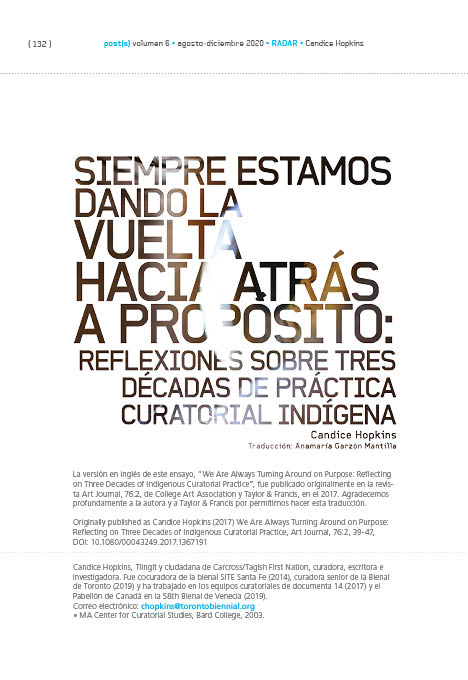We Are Always Turning Around on Purpose: Reflecting on Three Decades of Indigenous Curatorial Practice

Published 2020-11-23
Keywords
- curatorial,
- contemporary art,
- first nations,
- politics,
- art
How to Cite
Copyright (c) 2020 Candice Hopkins

This work is licensed under a Creative Commons Attribution-NonCommercial 4.0 International License.
Abstract
In Cherokee, Ni"™ Go Tlunh a Doh ka means "we are always turning around . . . on pur- pose."The name of an exhibition curated by Jimmie Durham and Jean Fisher in 1986, the title is also an apt metaphor and useful beginning for a set of reflections on the recent history of Indigenous curatorial practice.Turning around might imply spinning in place, yet it is also tactical as a means of changing course. For Maori in Aotearoa/New Zealand, you head into the future with your face turned to the past.This perspective foregrounds the importance of acknowledging what came before in order to contend with what comes next. For Indigenous peoples, it is an important way to pay homage to one"™s ancestors.This reversed gaze is also employed in this text, which charts a subjective history that loosely ties together a series of exhibitions of Indigenous art in the United States and Canada from 1986 to the present"”a way to look back- ward into the future. Looking back at these exhibitions reveals recurring themes and shifts within methods and approaches in exhibition-making in general and curato- rial practice in particular; these methods continue to shape this parallel discourse now.
Downloads
References
- Asamblea de las Primeras Naciones y Asociación de Museos Canadienses (AFN y CMA). (1994). "Pasando la página: forjando nuevas alianzas entre museos y Primeras Naciones". Informe del Grupo de Trabajo sobre Museos y Primeras Naciones, 3ª ed. https://museums.in1touch.org/uploaded/web/docs/Task_Force_Report_1994.pdf
- Cardinal-Schubert, J. (1990). "Surviving as a Native Woman Artist". Canadian Woman Studies/Les cahiers de la femme 11 (1, Spring), 50-51. https://cws.journals.yorku.ca/index.php/cws/article/view/11026/10115
- Durham, J., Fisher, J. y Smith, P. (1987). We the People [catálogo de la exhibición]. Artists Space.
- Fisher, J. (1987). "The Health of the People Is the Highest Law". Third Text 2 (Winter), 63-75.
- Fisher, J. (1992). "The Health of the People Is the Highest Law". En Revisions, ed. Helga Pakasaar. Galería Walter Phillips
- Fisher, J. (2013). "We the People: Notes on Curating Contemporary American Indian Art in the 1980s". https://www.jeanfisher.com/we-the-people-notes-on-curating-contemporary-american-indian-art-in-the-1980s/
- Fisher, J. y Durham, J. (Eds.). (1986). Ni 'Go Tlunh a Doh ka, ed. Fisher y Jimmie Durham [catálogo de la exhibición]. Galería Amelie A. Wallace.
- Goddard, J. (1991). Last Stand of the Lubicon Cree. Douglas y McIntyre.
- Martin, L. (Ed.). (2003). Making a noise!: Aboriginal Perspectives on Art, Art History, Critical Writing and Community. Banff Center for the Arts
- Ming, R. (2014). "Q&A: Tania Willard". Project Space. 10 de septiembre. http://projectspace.ca/qa-tania-willard, al 1 de agosto de 2016.
- Parlee, B.L. (2015). "Avoiding the Resource Curse: Indigenous Communities and Canada"™s Oil Sands". World Development 74 (octubre), 425-36. https://www.sciencedirect.com/science/article/pii/S0305750X15000637
- Simpson, P. (2013). "Sidelined No More". The Big Beat. 12 de febrero. https://ottawacitizen.com/life/style/our-ottawa/sidelined-no-more recuperado 6 de agosto de 2016.
- Smith, J.G.E. (1987). "Canada "” The Lubicon Lake Cree". Cultural Survival. https://www.culturalsurvival.org/publications/cultural-survival-quarterly/canada-lubicon-lake-cree
- Smith, P.C. y Warrior, R.A. (1997). Like a Hurricane: The Indian Movement from Alcatraz to Wounded Knee. New Press.
- Townsend, M., Claxton, D. y Loft, S. (Eds.). (2006). Transference, Tradition, Technology: Native New Media Exploring Visual & Digital Culture. Banff Center for the Arts.

